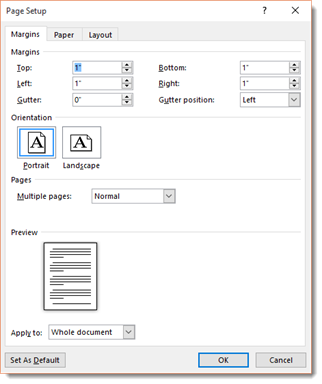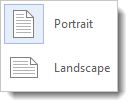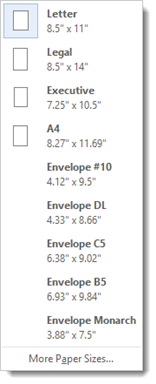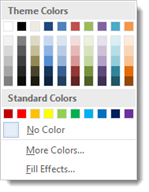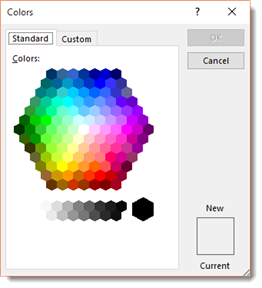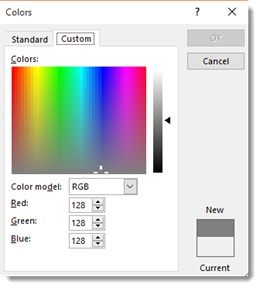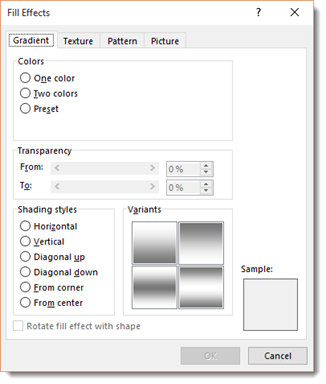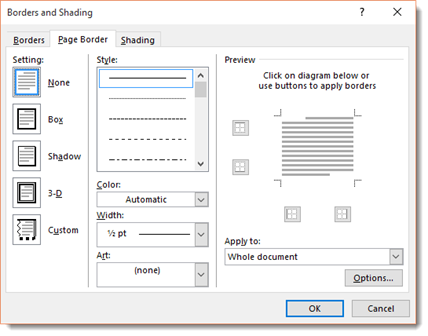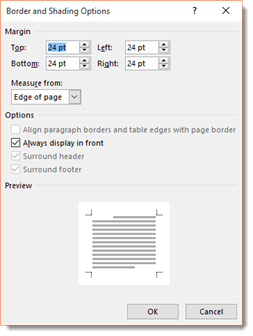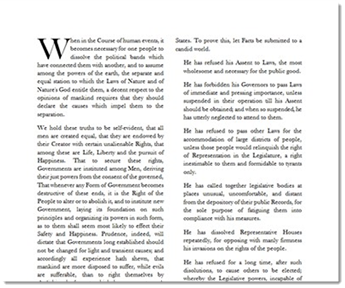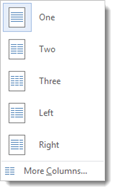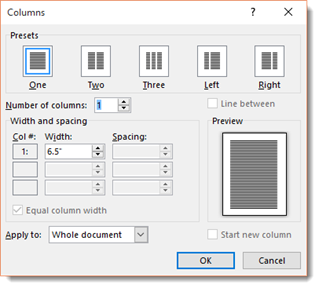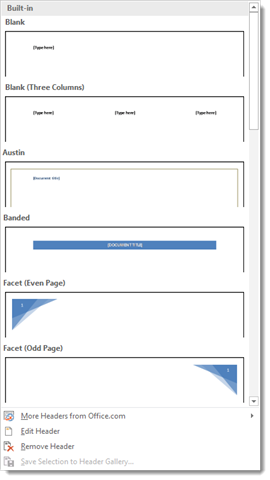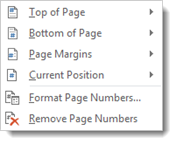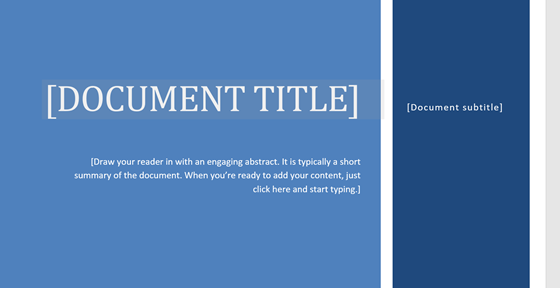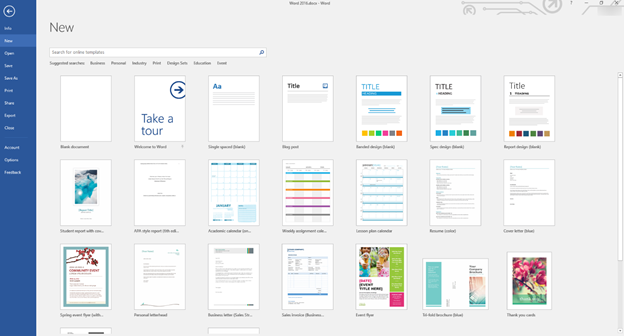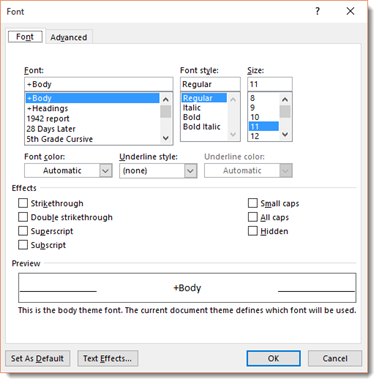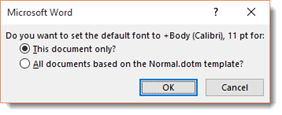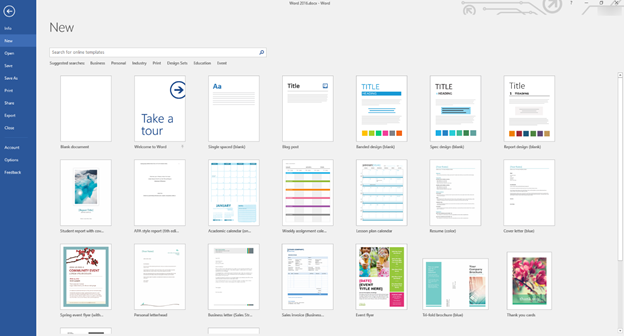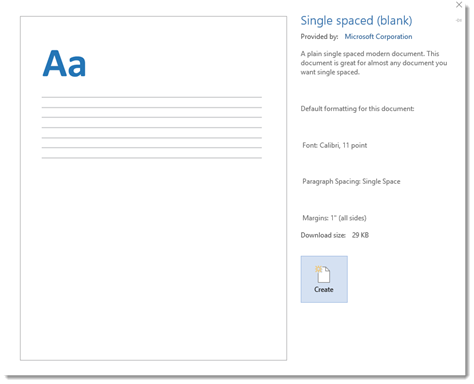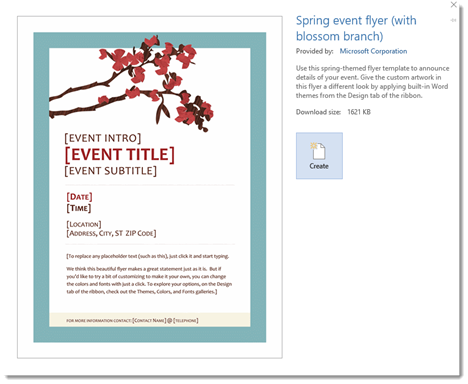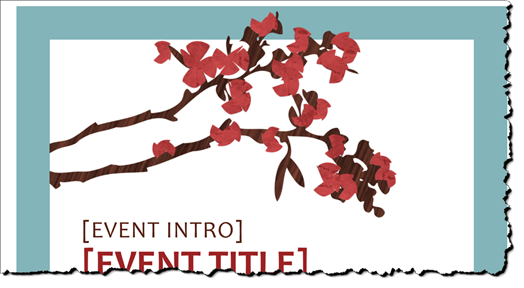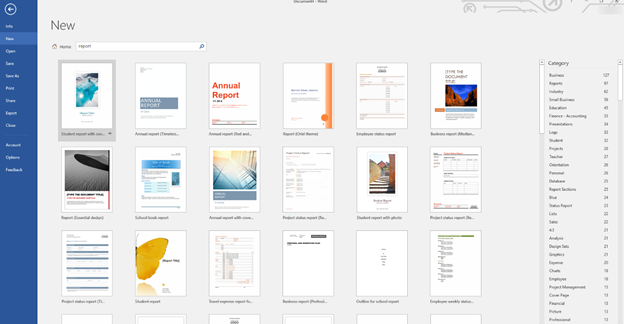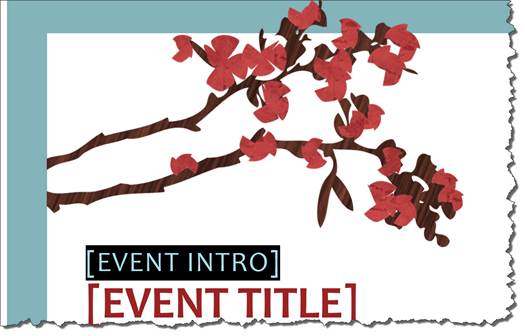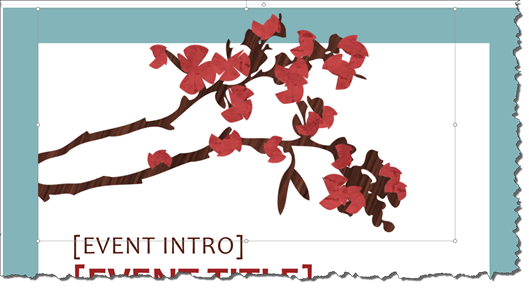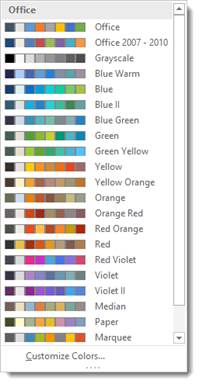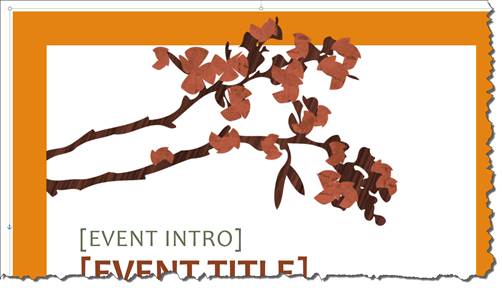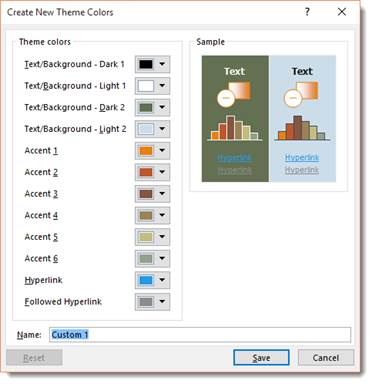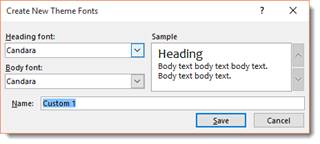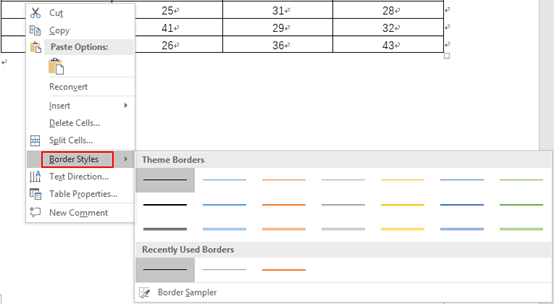Perhaps one of the most important things you can learn in Microsoft Word is how to format your page with elements such as margins and page breaks. Formatting your pages makes them look more attractive and makes them easier to read. Plus, it’s easy to do with Word 2016.
Page Margins
Page margins are the white space around the top, bottom, left, and right of your document. Margins let Word know where to start placing text at the top of a document, when to move on to the next page at the bottom, where to start typing text on the left side, and where to stop and move to the next line on the right.
Changing or setting page margins in Word 2016 only requires a few simple steps. It really doesn’t take any time at all once you know where to go and what to do.
To change or set the page margins, click the Layout tab on the ribbon, then go to the Page Setup group.
Click the Margins button. It looks like this:
Normal margins are one inch margins at the top, bottom, left, and right.
To set your own margin, click Custom Margins at the bottom of the dropdown menu.
You will then see the Page Setup dialogue box.
Enter the margin measurement in inches for the top, bottom, left, and right margins.
Click OK when you’re finished.
How to Change the Orientation of a Page
When we talk about page orientation, there are two different orientations: landscape and portrait. Landscape and portrait refer to how the document will be displayed on screen and printed. Choose Landscape and your document will be printed horizontally. This is the most common orientation. If you select Portrait, it will be printed from top to bottom (vertically). This is best for professional photos of several people. If your document contains several photos, you may want to choose Portrait.
To set the orientation, go to the Layout tab. Click the dropdown arrow below the Orientation button.
It looks like this:
You will be asked to select between Landscape and Portrait.
Change Page Size
Let’s learn how to adjust the page size of your Word document.
The default page size in Word is 8.5 x 11, the same as standard printing paper. However, for different types of documents, you may need to change the page size.
To change the paper size, go to the Layout tab. Click the downward arrow below the Size button.
Clicking on this will produce a drop down menu with different sizes that you can choose from.
Choose the size of your final document. You can choose legal, A4, credit card size, etc.
Page Colors
Changing the page color is self-explanatory. To do so, click the Design tab and then the Page Color button.
Simply select a color from the menu.
To create your own color, click «More Colors.»
Under the Standard tab, you can click on a color to select it, as shown above.
If you click the Custom tab, you can use the color picker by clicking your mouse anywhere on the color that you want, then use the slider to adjust the color to create the exact shade you want.
To add a gradient, texture, pattern, or picture, click «Fill Effects» in the Page Color dropdown menu.
In the Fill Effects dialogue box, you can add a gradient, texture, pattern, or image to use as a background for your document.
Borders and Shading
Borders can be applied to an entire page, an entire document, or just certain sections of the document. A border can also be applied to paragraphs.
To put a border around a page or a paragraph, go to the Design tab and click the Page Borders button in the Page Background group. It looks like this:
When you click the Page Borders button, a new dialogue box opens.
Use this window to define the attributes of your border. You can choose to remove a border by clicking the None box. Select a style, width, and color. You can even select some predefined artwork from the Art dropdown box.
Using the Apply To dropdown, you can choose whether to apply these settings to the entire document or just certain pages or sections.
Now take a look in the lower right hand corner of the window where it says «Options.» Click that for even more control over your border and shading options.
From here, you can choose the margins of your border, and whether or not to measure that from the edge of the page or the edge of the text. Click OK when you’re finished.
To add shading to a page, click Page Borders and then Shading from the Borders and Shading dialogue window. Select a color from the Fill dropdown menu, and a style. Click OK when finished.
Using and Formatting Multiple Columns
By default, a blank document contains one column. The text begins at the left margin and runs straight across the document to the right margin. However, if you’re creating a newsletter or brochure, you might want to add multiple columns
There are several benefits to using multiple columns. They can:
- Make your documents easier to read
- Make them visually interesting
- Make them look professional
- Allow you to use space more efficiently
Below is an example of a document that was made more interesting simply by breaking the text up into columns.
Adding columns to a document is incredibly easy. Go to the Layout tab and click the Columns Button in the Page Setup group.
Select how many columns you want to use in your document.
For precise control over the column width and spacing, click «More Columns….»
In the dialogue box pictured above, you can adjust the width of the column, as well as the amount of space between columns. You can also decide if you want the columns to apply to the whole document or from the current point in the document forward.
Click OK when finished.
Insert Headers and Footers (Including Page Numbers)
A header appears at the very top of a document. It typically includes the page number and title of the book.
A footer appears at the bottom of a page. It can also contain a page number.
If you want to insert header and footer information (page numbers, title, date, etc.) into your document, you first have to decide if you want headers or footers. Remember, headers go at the top of the page. Footers go at the bottom.
To insert headers or footers, go to the Ribbon and click on the Insert tab.
Go to the Header & Footer Group, the click on either Header or Footer.
We’re going to choose Header.
After you click on Header, choose a header style from the dropdown menu, as pictured below.
Once you select your style of header, it will take you back to your document where you can then insert the header information, including title, page number, date, etc.
The same steps are applied when you click on Footer.
If you simply want to insert page numbers, then click the Page Number button that is to the right of Footer button. A dropdown menu will appear which will allow you to choose where to place the page numbers.
Choose where you want to place the page numbers. You can also format and remove page numbers.
NOTE: If all you want to do is add page numbers, this is quicker and easier to do then going through the Header or Footer dialogue.
Create a Page Break
A page break is the point where one page ends and another begins.
To create a page break:
-
Go to the Insert tab.
-
In the Pages group, click the Page Break button. It looks like this:
Insert a Cover Page
A cover page is inserted before the first page of your document. It contains information such as the name and author of the document. It can also contain image and other graphics to make the page more attractive. Cover pages are commonly used for longer documents, such as reports and books.
To insert a cover page, click the Insert tab on the Ribbon, then click the Cover Page button in the Pages group. It looks like this:
From the dropdown menu, choose a style for your cover page.
To edit the text on your cover page, hover your mouse over the placeholder text, then click to see the cursor.
Type the text that you want to appear.
If you want to remove the cover page, click the Cover Page button again and select «Remove Current Cover Page».
Insert a Blank Page
When creating longer documents, you may want to insert a blank page between sections or chapters.
To insert a blank page, click the Insert tab on the Ribbon.
Select Blank Page from the Page group. It looks like this:
The blank page will appear after the current page.
Templates
Templates are documents that are already designed for you.
When you use a template, all you have to do is replace the sample text and images with your own. They help you save oodles of time and keep your documents consistent. In Word 2016, you can even edit the templates or create your own and then use them again and again.
Changing the Default Document Template
Whenever you open a blank document in Word, you are opening a template—one in which the margins, font, and themes are already defined. This is called the default template. It’s not as fancy as some of the templates you see pictured when you go to File>New, but it’s still a template. You can edit this template in the same way you’d edit the fancier templates.
To make changes to the default template, let’s take a look at the Font group under the Home tab.
As you can see, the selected font is Calibri, size 11. This is the default font for Word 2016. But let’s say you’re a professional writer, and your editor is a stickler for old-school standards. That means he wants a fixed width font like Courier New, size 12, with double spacing. Since you write almost exclusively for this stodgy old editor, you don’t want to have to go in and change those values every time you open Word.
The solution is easy. Click the little arrow at the bottom right corner of the Font group to open the Font dialogue box. Click the Font tab.
Choose the font and size you want, and then click the «Set As Default» button in the lower left hand corner of the window.
Another dialogue box will open, asking you if you’d like to set this font size and style as the default for this document, or all documents based on the Normal template.
If you want to use 12pt Courier New every time you open a new document, select «All documents based on the Normal template?» You can change these values anytime you like.
To change the default paragraph values, you click the box with the arrow in the lower right hand corner of the Paragraph section of the ribbon. You can change default Margins in the Page Setup section, and so on.
Opening an Existing Template
Microsoft provides a number of templates to make your work easier. They can help you create a budget, write professional letters, design flyers and for Microsoft and more. If you are connected to the Internet, you can browse through and download literally thousands of existing templates from Office.com…without ever leaving Word 2016.
If you already have Word 2016 open, you can view the templates by clicking the File tab, then going to New. You can then see the templates just as you did on the start screen.
As you can see, the blank document template appears first, followed by a tour of Word 2016. Next, you have a single spaced plain document. If you click on it to open it, Word shows you the features of this template:
Click the Create button to create the template.
Now, let’s choose the Spring Event Flyer template, and open it up so we can show you an example of a Word template.
Again, Word gives us information about this template.
Click the Create button. Word will load the template for you.
Search for a Template
There are a lot of templates in Word. The thumbnails you see when you go to File>New are only a small sampling.
Word 2016 gives you a few ways to search for a template you want. Go to File>New. At the top of the screen, you’ll see this:
You can type in the kind of template you want. Let’s say we want a report.
Type in report.
Word then searches its online database for a report template, then shows you the results:
You can see all the results pictured on the screen. To the right, you’ll see the category pane where you can search for a report template by category. Simply click on a category to see its reports.
You can also search for a template by clicking on one of the suggested searches below the search box.
Create and Save a New Template
In addition to the thousands of templates available in Word 2016, you can create and use your own. To do so, simply create the document and when you are finished, then click File>Save As. Select the location you want to save the template to, then select «Word Template» or «Macro-Enabled Word Template» from the «Save as Type» drop down menu.
Change the attributes of the style to suit your preferences, then click OK.
Modifying a Template
Let’s go back to our Spring Flyer Event template that we showed earlier:
Once you’ve opened a template, you can now make changes to it. You can change the font size, font color, etc. if you want, and you can also customize the text to make the template your own document.
To edit the text, click on the text that you want to edit. It then selects the text, as shown below.
Now simply type the text you want, as shown.
While the text is selected, you can also look in the Style gallery to see the style applied to it.
You can modify the style to change the formatting.
Click on any image in a template, and you’ll see a bounding box appear around it:
You can then cut or copy the image.
If you want to change the colors used in the template (such as the border colors), you can do that by changing the theme.
Working with Themes
Like templates and quick styles, themes are another way to achieve consistency in your documents. Themes can include font styles, color palettes, and special effects. What they do is give you a group of fonts, colors, and special effects that work well together and even complement each other. This can be illustrated by taking a closer look at some of the themes.
Themes are located under the Design tab.
We can change the theme from the template above by simply choosing a new theme from the Themes dropdown menu.
We can also choose a new color scheme by clicking the Color button on the far right side of the Document Formatting group and choosing a new one:
Let’s choose Yellow Orange.
That’s all it took to change the colors in our template:
Applying a Document Theme
So far, we’ve talked about modifying or changing a template’s theme. However, you can also apply a theme to your documents that you create.
Before we learn how to do that, it’s important to understand exactly what a theme is, so you know how it applies to your text. A theme consists of three things: Colors (of graphics and design elements, background color, text color, and hyperlinks), fonts (headings and body text), and graphical effects such as 3-D, shading, drop shadows, etc.
To apply a theme, select a theme from the Theme Gallery under the Design tab. You can mouseover any theme to preview what it will look like in your document, just like you did with styles. Simply click on a theme to apply it to a document.
Modify or Create a Theme
If you want to create a custom color theme (or a color scheme that you create instead of the ones Word has built in under the Color button), click the Color button under the Design tab, then select Customize Colors.
Choose the colors for the various elements, then enter a name for your new color theme. Click Save when you’re finished. This new theme will now appear with the other themes.
To create a custom font theme, click the Fonts button under the Design tab and choose Customize Fonts.
Click Save when you’re finished.
Launching a Microsoft Word document is akin to starting with a clean slate, or a fresh piece of digital paper. While all of that white real estate can give you lots of space for your typed text, the default black on white can get a little monochromatic for some requirements. Liven up a Word document by adding a colorful border. With Word’s auto-formatted borders, you won’t have to create lines or adjust anything to fit the page’s margins, as it’s all done for you. Just choose a design and get colorful.
-
Start Microsoft Word. Click the “Page Layout” tab at the top of the screen.
-
Click the “Page Borders” button in the middle of the ribbon below the tab.
-
Click the “Box” button on the left of the “Page Border” tab’s window. Click the “Color” drop-down menu and choose a color for the border. This color will apply to any black default borders under the “Style” or “Art” drop-down menus, but you can still get more colorful.
-
Click the “Art” drop-down menu in the middle of the window. Scroll through the options, which include colorful flowers, Aztec-like patterns and holiday themes, all in multi-color shades.
-
Select one of the borders. Note that even if you chose a color in the “Color” drop-down menu, one of these “Art” borders will override that choice and use the full-color scheme it was created with.
-
Check the “Apply to” menu on the right side of the window. If it does not say “Whole Document,” select that option.
-
Click “OK” to close the window and return to the Word document, now with a new colorful border.
Download Article
A user-friendly guide to changing a Word document’s margins to wide, narrow, and more
Download Article
- Applying Preset Margins (Desktop)
- Creating Custom Margins (Desktop)
- Using the Mobile App
- Q&A
- Warnings
|
|
|
|
Are you trying to adjust your margins in Microsoft Word? The margins are the empty space between the edge of the page and the contents of the document. Depending on your needs, you can change the margins to become wider, narrower, or a mix of both. You’ll be able to select from a few preset options or customize your own. This wikiHow will show you how to fix and change the default 1-inch margins in Microsoft Word using your iPhone, Android, or Windows or Mac computer.
Things You Should Know
- On desktop, click «Layout» → «Margins» → select a margin preset.
- For custom margins, click «Custom Margins…» and enter the values for Top, Left, Bottom, and Right.
- On mobile, tap «•••» → «Home» → «Layout» → «Margins» → select a preset or «Custom Margins». Enter a new value and tap «Done».
-
1
-
2
Click Layout. This will be in the top toolbar, between Design and References.
Advertisement
-
3
Click Margins. You can find this in the upper-left corner of the Layout tab. This looks like a rectangle with blue lining the margins.
- A pop-up menu will open.
-
4
Select a margin type. You’ll see a list of preset margins: Normal, Narrow, Moderate, Wide, Mirrored, and Office 2003 Default. Click a preset margin to apply it to your document. It should be applied immediately.
- If you don’t like how it looks, you can select Normal again, or press CTRL + Z (Windows) or CMD + Z (Mac) to undo the change.
Advertisement
-
1
Click Layout. This will be in the top toolbar, between Design and References.
-
2
Click Margins. You can find this in the upper-left corner of the Layout tab. This looks like a rectangle with blue lining the margins.
- A menu will open.
-
3
Click Custom Margins…. This will be at the bottom of the drop-down menu.
- A new window will open.
-
4
Set your new margins. On the desktop application, you’ll be able to edit the margin sizes for: Top, Left, Bottom, Right, Gutter, and Gutter Positions. On the web version, you’ll only be able to edit the margin sizes for: Top, Left, Bottom, and Right. You’ll see a preview of the document layout at the bottom of the window.
- Click the field and enter your new margin size, or use the up/down arrow to adjust the current margins.
- For Gutter Positions, select Left or Top.
- Only adjust the Gutter margin if you intend to use the document in a bound format, like a book or report, and you need space for the binding. In this case, type a number in Gutter that will allow enough room for the binding and use the drop-down to indicate whether the binding will be on the top or on the left.
- Make sure Apply to is set to Whole document, unless you only want to change the margins from This point forward.
-
5
Set new default margins (optional). If you want to use this margin for all new documents in Microsoft Word, click Set as default in the bottom-left corner. Click Yes to confirm.
- When you create a new document, the margins will reflect the change.
-
6
Click OK when finished. The changes will be applied immediately.
Advertisement
-
1
Open the Microsoft Word app. Microsoft Word is available for iOS in the App Store and for Android in the Google Play Store.
- If you aren’t already logged in to your Microsoft account, enter your email address and password to do so now.
-
2
Open a new or existing project. Tap a recent project on your homepage, or tap the + tab to create a new one.
-
3
Tap ••• . This is the «•••» located at the top of your on-screen keyboard. If you don’t see your keyboard, tap the document to open it.
- A new menu will open at the bottom.
-
4
Tap Home. This is located at the top of the new menu.
- A pop-up menu will open.
-
5
Tap Layout. You can find this between Draw and Review.
-
6
Tap Margins. This is the first listing in the Layout tab.
-
7
Select a margin type. You’ll see a list of preset margins: Normal, Narrow, Moderate, Wide, and Mirrored. Tap a preset margin to apply it to your document. It should be applied immediately.
- If you don’t like how it looks, you can select Normal again, or pick a new preset.
- Be sure to save your document when you’re finished.
-
8
Create a custom margin (optional). Tap Custom Margins at the bottom of the Margins menu. You’ll be able to edit the margin sizes for: Top, Left, Bottom, and Right.
- Tap a margin to edit it.
- Tap the backspace button to erase the existing margin.
- Enter a new margin value.
- Tap Done in the top-right corner.
- Tap Margins → Custom Margins to edit another margin.
- The changes will be applied immediately.
Advertisement
Add New Question
-
Question
I want the page ruler. What can I do?
To get the ruler, go into the View tab (Word 2010 and newer) and select the Ruler checkbox.
-
Question
Can I ever allow one more letter on a line to finish a long word rather than wrap to the next line?
No. The only thing you could possibly do would be to make all the margins wider. Making only one word go to the next line is impossible unless you do the same for all words.
Ask a Question
200 characters left
Include your email address to get a message when this question is answered.
Submit
Advertisement
Thanks for submitting a tip for review!
-
Leaving the margin under .25″ may lead to text being cut off when printed.
Advertisement
About This Article
Article SummaryX
1. Open a Microsoft Word document.
2. Click the Layout tab.
3. Click Margins.
4. Click Custom Margins….
5. Set the margins.
6. Click the Apply to drop-down.
7. Select how to apply the margins.
8. Click OK.
Did this summary help you?
Thanks to all authors for creating a page that has been read 493,209 times.
Is this article up to date?
Every time you insert a table in Word document, the color of borders is black by default. If you want to make some changes to express your personal style, try these methods below.
1. Borders and Shading
Select the whole table. Click Home tab, find the button of Borders in the lower right corner of Paragraph section. Then select Borders and Shading… in the drop-down list.
Click the drop-down arrow beside Automatic color in Borders tab, choose the one you like in the list or click More Color to customize it. Then hit OK to confirm your choice.
Now the change has been made to your table.
2. Borders Styles
Right click any section of the borders, put your cursor at the selection of Border Styles. You can see a list of Theme Borders.
Choose a style of borders you like and your cursor will become an icon of paintbrush. You can then click any section of borders to turn it into the style you choose. In this way, you can make your table more vivid with multiple different colors.
Copyright Statement: Regarding all of the posts by this website, any copy or use shall get the written permission or authorization from Myofficetricks.
Trying to create an attractive and engaging document in Microsoft Word? Need to arrange content so that it fits perfectly on a page? You should be thinking of how to change the margins in Word.
By making this quick change, you can transform the appearance of any Word project. It only takes a few clicks. In this tutorial, we’ll teach you how to change margins in Word so that you’ve got complete control over your document.
Why Adjust Margins in Word?
Margins in Word are a powerful way to control the layout of your document. In essence, they control how far text and numbers sit from the edge of each page.
Microsoft Word margins default to one inch on all four sides of a page. This means that characters start (and end) one inch from the side of each page. In many instances, this is the perfect measurement. After all, it’s the one you’ll most commonly see on documents of all types.
It’s amazingly easy to learn how to change the margins in Word. And there are great reasons to do exactly that! Changing margins gives you precise control over the layout of each page in your document. Depending on the nature of your project, you may want to change margins in Word to alter how content fits onto a page.
Think with the end in mind as you set your margins in Word. Imagine, for example, that you’re designing an event poster. The goal here is to share as much as possible on a single sheet. Narrow margins are a perfect choice here. This way, you can pack more material onto your poster.
Or consider a scenario like this one:
You’re designing a certificate that you plan to print out and frame. The frame will cover the edges of the printed page. Choose narrow margins, and chances are, you’ll cover up some of your text! In this case, wide margins are your friend. They move characters toward the center of a page, leaving ample open space around the borders.
Microsoft Word margins are easy to adjust, and they’re a design tool that you should never forget. Often, it’s useful to try out different settings before completing your document. In just a few clicks, you can change up the look and feel of any page. Margins are the perfect way to creatively control the readability of your projects.
How to Use Margin Settings in Microsoft Word
Margins are a measurement setting that you can easily adjust. In Word, you’ve got many ways to adjust your page margins. The first step is to think back to our examples above. Here are some questions to consider:
- What type of document are you creating?
- What margin settings will look and work best for you?
- What paper will this document eventually print on?
From here, you’ll need to decide how much control you need. And you can decide what settings fit the circumstance. Microsoft Word offers several preset margin settings that you can apply instantly. These work in many instances, and save you the work of adjusting margins manually.
Microsoft Word documents are best created using premium templates. When you browse the vast Envato Elements library, you’ll find thousands to choose from. With the powerful Elements unlimited-download offer, you can use as many as you want! Each one can then be transformed by changing the margins in Word.
Let’s learn how to change margins in Microsoft Word. To follow along, download the beautiful Letterhead Word Template from Envato Elements. It’s a great template that illustrates the power of margin management. We’ll use it in the tutorial below.
The tips in this tutorial were written using macOS and Office 365. If you’ve got a different operating system or a different version of Microsoft Word, your steps may be slightly different.
Review Your Word Margin Settings
To explore how to change margins in Microsoft Word, let’s first consider these margin options. Remember, margins in Word default to one inch under default app settings. You’ll see this referred to as the Normal setting. When you build a new Word document, this is the setting that you see.
To change the margins in Word, start by going to the Layout tab. You’ll find this on the ribbon, the series of menu tabs across the top of the screen (beginning with Home and Insert). With Layout selected, you’ll see several drop-down menus. The one you need is on the far left side, and it’s labeled Margins.
Click the Margins dropdown arrow, and you’ll see the preset margin size options displayed. As mentioned, Normal is the default selection. Below, you can choose from others, like Narrow, Moderate, and Wide. With each, the precise measurements are listed, along with a preview image.
Click on any setting to apply it. As you do, Word automatically adjusts any content that you’ve added to the page. Test it out to spark your thinking about how margins in Word work. You might have an idea about how to fit a document that didn’t fit in the past.
How to Apply Custom Margins
In many cases, preset Microsoft Word margins give you the control you need over your page layout. But there may be times where you need more detailed control. In those cases, Microsoft Word has you covered.
This is where Custom Margins come into play. This is a robust feature in Word that lets you adjust margins to an exact measurement that you specify. No margin is out of reach, and that helps you address totally custom documents.
To customize margins, return to the Margins drop-down on the Layout tab. Below the list of pre-built options is the Custom Margins button. Click on this, and Word launches a menu called Document.
The Document menu is the control center for page layouts in Microsoft Word. Always remember it as you think of how to change the margins in Word. With it open, you’ll see that you can adjust each of the four margins to an exact measurement.
In the screenshot above, you’ve got two options. You can type in custom values into the white boxes (in inches). Or you can adjust up and down in 0.1-inch increments by clicking on the arrows. Sometimes, it pays to experiment with these settings with those pre-built options.
By doing so, you can customize margins to be any size that you want. This lets you craft a unique and dynamic document with the content placed exactly where you need it.
By the way, you’ll notice a setting here as well called Gutter. This applies to documents that are going to be bound, like a book or magazine for example. Add a gutter setting for extra spacing between pages on the inside or top side of the document.
When you’re finished, click OK at the bottom of the Document window. Your margins in Word are applied, and you can resume editing and customizing each page.
More Ways to Edit Margins in Word
You’ve seen how to change margins in Microsoft Word. With custom or default settings, you can control how text fits onto a page. But with Word margin settings, you’ve got more options available to you. To explore them, return to the Margins > Custom Margins button to launch the Document menu.
Below the four margin control boxes, you’ll see some extra options. The first of these is Gutter. Gutter is a specialty control useful if you plan to print and bind your Word document. It helps ensure that text won’t be obscured on the edge of your pages during the binding process.
Changing the Gutter setting works like adjusting any other margin setting. Simply type in a custom value in the box or arrow up and down to choose a measurement using the buttons on the right.
Next up, you can control multi-page margin options, in the Pages section. Launch the Multiple Pages dropdown menu by clicking on it.
Inside, there are three selections: Mirror Margins, 2 Pages Per Sheet, and Book Fold. Choose among them to do the following:
- Mirror Margins. This is common in two-sided printing, and controls how facing pages appear to each other.
- 2 Pages Per Sheet. This cuts a sheet in half horizontally and fits two pages of content onto the original single sheet.
- Book Fold. This cuts a sheet in half vertically and fits text into a column-style layout.
Finally, in the Apply To section, you can control where your settings appear. By default, changing margins alters the Whole Document. Or you can choose This Point Forward to keep settings you’ve already applied to previous pages.
Again, when you’re finished, press OK. Your Word margin settings are applied. Make sure that your content appears as you expect, and it now fits on your page. Sometimes, changing the margin moves content in an unexpected way, so quality control is essential.
You’ve learned how to change margins in Microsoft Word using a variety of settings and options. As you can see, it’s amazingly easy! This is a quick way to customize the look and feel of any document in 2022.
The Best Source for Top Margin Microsoft Word Templates (In 2022)
Premium templates are the best way to build stunning documents in Microsoft Word. And the best source for them is Envato Elements. As a subscriber, you’ve got access to thousands of stunning MS Word templates available now.
The Elements offer is unbeatable: unlimited downloads. For a flat monthly rate, you get access to as many premium Word templates as you want.
Use these templates as you change margins in Word. With Elements, you’ll enjoy expertly-crafted layouts that you won’t find anywhere else. Yet, you keep full creative control. You can change the margins of any template to perfectly fit your needs.
Explore Word Templates
This is only one of the benefits of Elements. You’ll also have access to:
- Stock photos
- Beautiful custom fonts
- Graphics and themed templates
All of these digital assets fit well on your Word documents to create memorable projects in a flash. As you can see, Envato Elements is the best value for creatives in 2022. Explore the vast library and join Envato Elements today.
Now You Know How to Change the Margins in Word
Learning how to change margins in Microsoft Word gives you complete control. That means that your documents appear exactly as expected. Whether in print or as a digital document, setting the margins helps you create a great finished product.
Start putting what you learned into practice today. Now that you know how to change the margins in Word, think about that document that didn’t fit on the page when you tried to print it. Practice how to change margins in Microsoft Word with the tips you just saw.
Did you find this post useful?
I believe that life is too short to do just one thing. In college, I studied Accounting and Finance but continue to scratch my creative itch with my work for Envato Tuts+ and other clients. By day, I enjoy my career in corporate finance, using data and analysis to make decisions.
I cover a variety of topics for Tuts+, including photo editing software like Adobe Lightroom, PowerPoint, Keynote, and more. What I enjoy most is teaching people to use software to solve everyday problems, excel in their career, and complete work efficiently. Feel free to reach out to me on my website.



